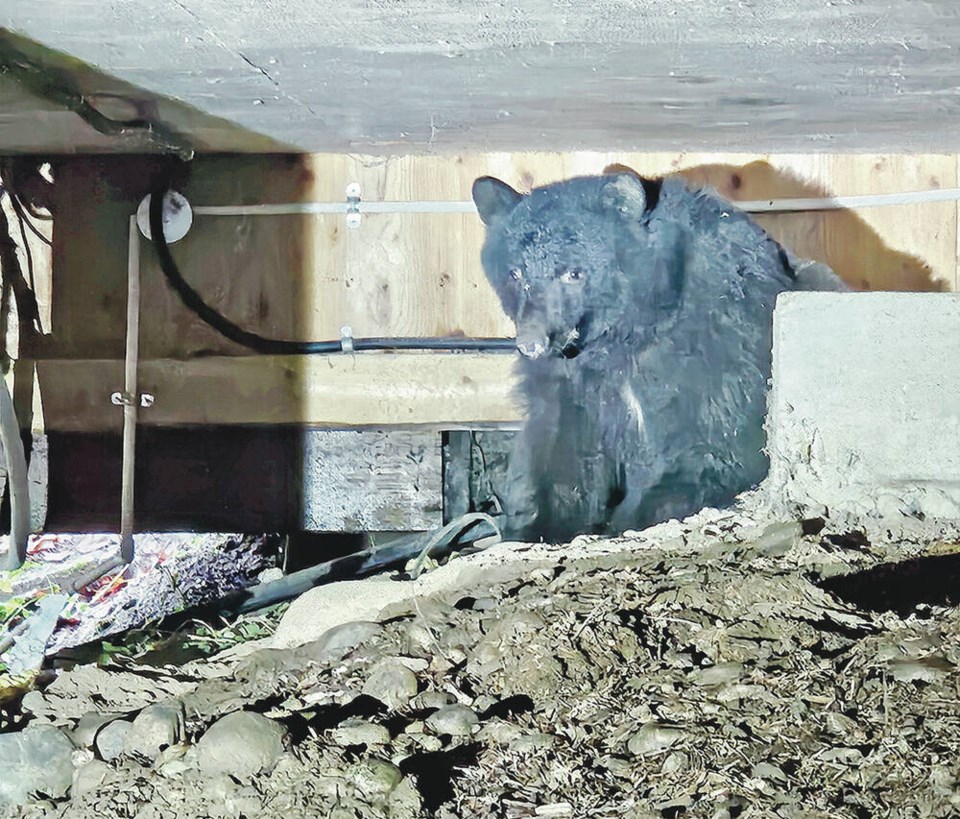Their dog was acting oddly for days, barking and zipping around the yard. And then the thumping started.
Crystal Weaver and Tylor Weikle knew something was up under their home along the banks of the Cowichan River.
“We were in bed and thought it might be raccoons or something … we’ll check it out in the morning,” said Weaver.
Early on Dec. 28, Weikle and Weaver crawled under the deck — and found a black bear staring right back at them.
“I’ve never seen my husband move so fast,” said Weaver. “He said ‘Oh my God,’ [and] put it into reverse, which was risky because there’s a cliff off the deck right above the river.”
The couple believe the bear picked the dry, dark area under their home to den down for the winter.
They had seen the bear fishing in the river and passing by their fence on a regular basis through the summer and fall, as their home borders a wildlife corridor.
But they didn’t want a bear living under them during hibernation, which can be up to six months.
Weaver and Weikle tried to scare the bear away by jumping on the deck and shouting. “The bear was clearly not scared,” she said
When the bear stayed put, Weaver called the B.C. Conservation Officer Service, stressing she didn’t want the bear put down, only moved along.
She said conservation officers used a paintball-style gun that shot chalk bursts, pointing it near the bear, but not directly at the animal. “A few pop pops and the bear took off,” Weaver said.
The couple have since closed off the portion of the deck that leads under their home with wire and lattice, and spread cayenne pepper in the area because bears can’t stand the smell of it.
With the coast clear and nerves settled, Weaver decided to post her video and photos of the bear to the social-media platform TikTok, dedicating them to her beloved pooch Coco, who had been sounding alarm bells for weeks.
“She barks at seagulls and trash cans … [but] I have to believe her now,” said Weaver with a laugh.
She was shocked when the video went viral, attracting 4.3 million views as of Wednesday morning — even though she only has about 50 followers.
Helen Davis, a Duncan-based biologist who has researched bear dens for three decades, said it’s possible the bear under the home was settling in for hibernation.
She said though black bears prefer to den in hollow trunks, root systems and stumps of old-growth trees, there have been several cases of bruins finding alternative and unnatural places.
She said logging practices in the Cowichan Valley and southern Vancouver Island have left fewer and fewer older trees suitable for black bears to den.
In Salmon Arm last March, a black bear was found hibernating under a mobile home. The bear had briefly awoken from its slumber and made it partially out of its hole under the trailer, where a young girl found it, but had crawled back in by the time conservation officers arrived.
Davis, a consultant with Artemis Wildlife, said male black bears on the Island hibernate for about four months and females up to six months. Females give birth in the den and need more time because babies are less than a pound at birth and need about 90 days of feeding before they can leave the den.
“There’s so little old growth left in the Cowichan Valley and even the stumps they might use are decaying,” said Davis. “And they’re not allowing even the second-growth trees to get big enough.”
In October 2022, B.C. Green party MLA Adam Olsen tabled a private member’s bill aimed at protecting more bear dens across the the province. Currently, the dens — also called critical nurseries — are only protected on Haida Gwaii and in the Great Bear Rainforest on B.C.’s north coast.
Olsen said Wednesday he will reintroduce the bill in February and is confident the NDP government will take a closer look at enforcement measures to protect bear dens province-wide.
“We want to make sure it’s not just a patchwork based on the goodwill of forestry companies,” he said. “[The bill] is sitting there waiting for action. Unfortunately, while it sits there, how much harvesting is being done before this gets done?
“Bears are being put in a dangerous spot where they might be coming into contact with human activity and possibly getting killed.”
Added Davis: “If it’s important to protect bear dens on Haida Gwaii and the Great Bear Rainforest, why isn’t it important in the rest of B.C.?”
Davis said black bear dens are reused over several decades and by generations of bears. The large older trees are needed by black bears to survive the wet, cool conditions in coastal B.C., but too many of the trees have been logged and foresters often can’t tell for sure which trees are dens.
She said Artemis has developed training and tools for forest licensees and contractors to help identify the dens and habitat.
In the meantime, the B.C. Conservation Officer Service said people should secure crawl spaces and other access points to all buildings to keep bears from getting in.
The service said bears can cause damage under homes, such as pushing on gas and water pipes, chewing on joists and dragging garbage under houses.
Weaver hopes her experience brings some teachable moments for others, saying making a den under a house allows a bear to become used to people, which can lead to trouble and possibly death for the bear.
>>> To comment on this article, write a letter to the editor: [email protected]




